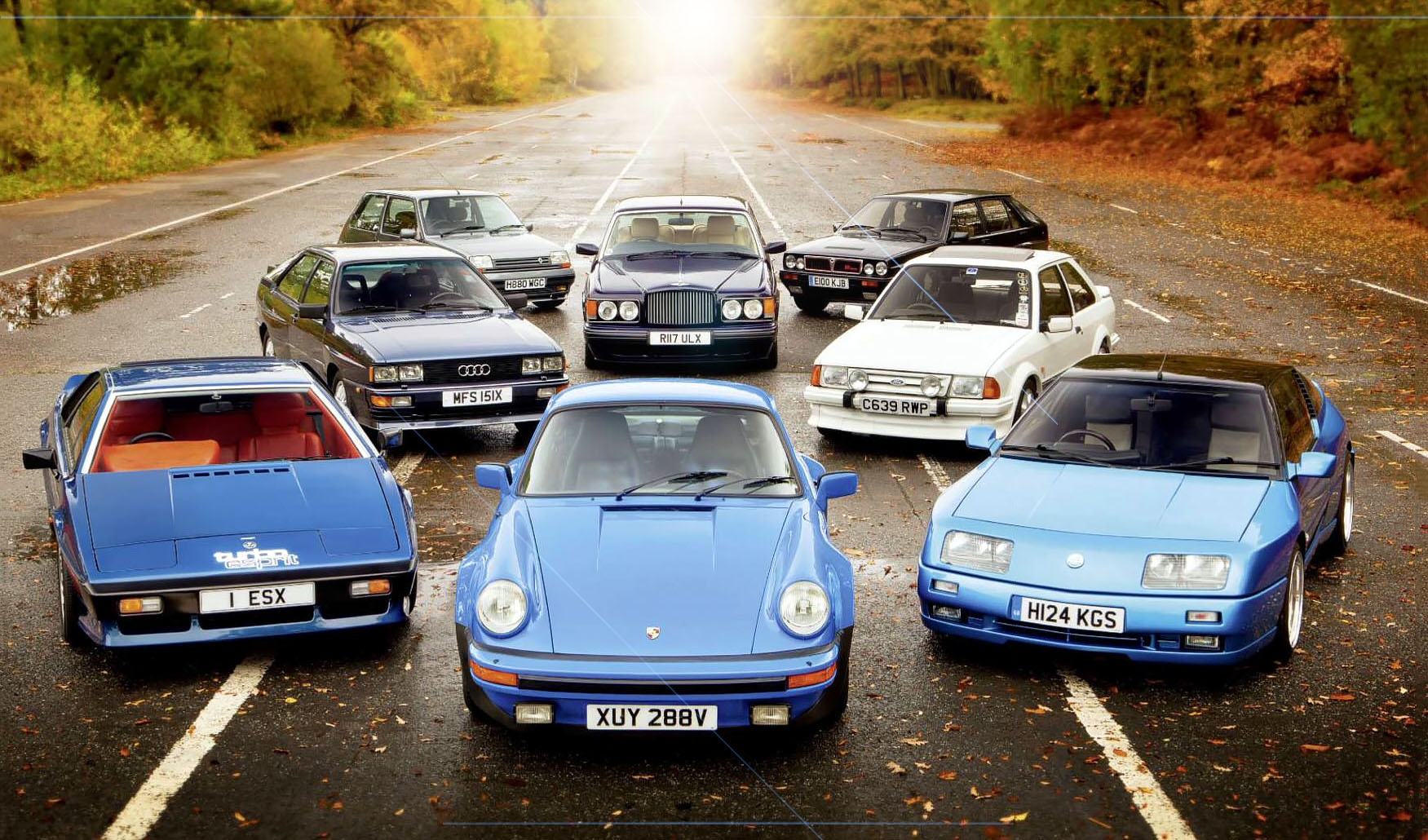
Turbo cars in the Eighties had an aura of daring and slightly uncontrollable speed. 1665bhp turbocharged shoot-out to find the best real-world thriller. Turbos Big Test Forced induction can provide a huge adrenalin rush, but which delivers the biggest thrills? We drive the Audi Quattro, Renault 5 GT, Ford Escort RS, Lancia Delta Integrale, Lotus Esprit, Bentley Turbo R, Porsche 911 and Alpine GTA to find out. Turbo Big Test L-R (from rear): Bentley Turbo R, Renault 5 GT Turbo, Lancia Delta HF Integrale, Lotus Turbo Esprit, Alpine-Renault GTA Turbo, Audi Quattro, Porsche 911 Turbo, Ford Escort RS Turbo Charged of the turbo brigade. At a stroke, forced induction created some of the motoring world’s greatest and most exciting superstars – but which gets the pulse racing fastest today? Words John Simister. Photography Laurens Parsons.
Turbo. It’s so much more than something to improve aspiration – to drive a turbocharged car in the Eighties was an aspiration in itself. Such a car had an aura of daring and slightly uncontrollable speed fostered by the exploits of mad Group B rally cars and grenade-spec Formula One qualifying engines.
You could buy Turbo aftershave or a Turbo vacuum cleaner. Prepubescent boys stuck posters of something – anything – turbocharged on their bedroom walls. Three decades on, turbocharging is a refined, computer-controlled part of the cleanrunning future of most car engines, performance-biased or not. So come back with us to a time when turbos were the fireworks up the exhaust pipes and the cars they were fitted to were a bit bonkers.
Turbo masters from (L-R, from rear) Renault, Bentley, Lancia, Audi, Ford, Lotus, Porsche and Alpine.

AUDI QUATTRO
Contemporary road tests eulogised the Quattro’s roadholding, observing that normal notions of understeer and oversteer weren’t relevant until you were driving at hitherto unimaginable cornering speeds. Ultimately it would drift its tail a little under power, its driver in an unreal world of seeming invincibility, until realisation dawned that the usual laws of physics did still apply when braking was involved. And there was no ABS.
Typically for an early turbo engine, the Quattro’s compression ratio is low (just 7.0:1) so off-boost performance is feeble. There’s plenty of lag-inducing inertia in the KKK turbocharger too so it doesn’t feel particularly fast unless I work it hard, keeping the revs up and the boost blowing. When I drive it this way I’m treated to the lovely quarter-octave harmonic howl that is a five-pot’s sonic signature while wrestling with acceleration that comes in a series of bursts between gearshifts rather than a smooth flow.
The gearshift is oddly resistant and loose-feeling despite its compact gate and I feel detached from the action when I tackle the first few bends. It feels planted, yes, but also aloof – as though it knows best. And I’m always aware of its hefty nose weight.
Then I try a bit harder and it starts to come alive. I discover that I can steer it on the throttle through slippery bends but it’s quite a heavy, blunt instrument and the brakes lock surprisingly easily, so it’s tricky to make fine corrections mid-corner.
It might seem curious then that it set the world alight when it first hurtled through a forest stage. Hannu Mikkola, Michèle Mouton and Stig Blomqvist helped Audi to win the 1982 World Rally Championship and top-level rallying was never the same again.
Yet the Quattro was far from exotic in roadgoing form. The engine was lifted from an Audi 200 and given an intercooler, the rear differential was from a VW Iltis off-roader and the modified centre differential was first used in the VW Polo and Audi 50.
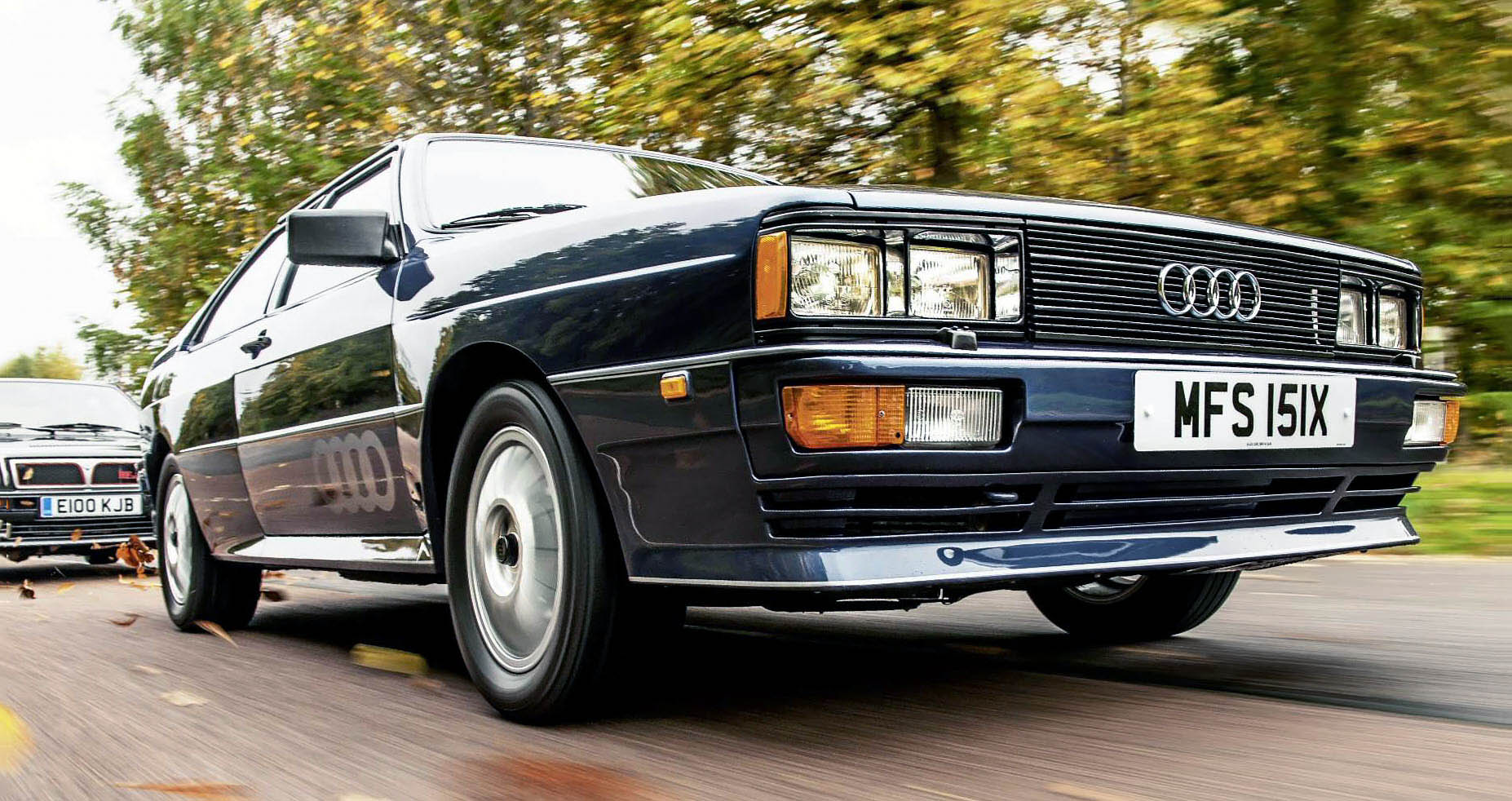
The bodyshell was based on the Audi Coupé, itself derived under the skin from the Audi 80 saloon, but where the humbler Coupé had a dead beam rear axle, the Quattro – still a capital ‘Q’ at this point, before the name signified any Audi four-wheel-drive system – replicated its front subframe and MacPherson struts. Seldom has four-wheel drive been shared so democratically between a car’s wheels – both centre and rear differentials can be locked manually by levers should the going be especially slippery.
So is this a world changer or just another superstar you’re better off never meeting? Driven today, it’s neither – it’s just a rapid and surprisingly practical period piece that would benefit from feeling friskier more of the time. You could have a nice one for as little as £5500 or a lovely late one for quadruple that, and the only recurring problem seems to be disintegrating exhaust manifolds.
‘Working the Audi hard is rewarded by the lovely quarter-octave harmonic howl that is a five-pot’s sonic signature.‘
OWNING ONE
David Ingram began to amass a collection of historic Audis when he was PR manager for Audi’s UK importer. He’s now retired but still the collection’s custodian.
‘One of our Scottish dealers had this early left-hand-drive Quattro as his private car. He’d supplied it new to a customer then kept it when it came back as a part-exchange. ‘We acquired it in 2005. It’s an early original car and was a proper official UK import; right-hand drive production didn’t begin officially for another 18 months.’
TECHNICAL DATA AUDI QUATTRO
Engine 2144cc, five cylinder, sohc, ten valves, Bosch K-Jetronic fuel injection, KKK turbocharger, intercooler
Power and torque 200bhp @ 5500rpm; 210lb ft @ 3500rpm
Transmission Five-speed manual, four-wheel drive
Steering Power-assisted rack and pinion
Suspension MacPherson struts, coil springs, lower wishbones, anti-roll bar front and rear
Brakes Servo-assisted discs all round, ventilated at front
Weight 1260kg
Performance Top speed: 138mph; 0-60mph: 6.5sec
Fuel consumption 22mpg
Cost new £14,500
Values now £5500-£22,500

Pre-1985 cars lacked oil pressure or water temperature gauges. Inline five uses Bosch fuel injection and ignition with Hitachi air mixture and engine load sensors.
{module Audi Quattro 156}
LANCIA HF DELTA INTEGRALE
Driving James Whelan’s well-worn eight-valve Delta HF Integrale serves as a reminder of what later Integrales lost as evolution took its course. It’s the nicest road car of them all in my opinion – not that it’s obvious on first acquaintance as I take in the seats and soft trim striped in colourful diagonals, feel the Recaro’s embrace and the rim of the small, rally-fugitive steering wheel, fumble with the flimsy stalks and try to make sense of the stack of plastic rectangles that comprise the dashboard.
The key ingredients to any Integrale are its transverse-mounted 1995cc, twin-cam engine with balancer shafts and a Garrett T3 turbocharger, and four-wheel drive via two differentials – epicyclic (with a viscous coupling) in the centre and Torsen at the rear. It’s all wrapped up in a Giugiaro-styled, square-edged five-door body that was already eight years old when the Integrale was introduced, but revved up with a set of expanded flat-topped wheelarch blisters much like the Quattro’s.
Into first gear – it’s a springy, rubbery shift action but finds its slot easily. We’re off with minimal lag and maximal smooth, rorty thrust. It’s a quick machine – faster to 60mph than the Audi despite a slightly less violent launch and more continuous in its urge. The steering feels ultra-quick and ultra-connected, telegraphing every last grip and torque variation through gentle power assistance.
I’m in a twisty, hilly, slippery, crest-filled road known as The Snake now and the Lancia manages the genius trick of feeling simultaneously glued to the tarmac – that’s the suspension’s rallystage suppleness for you – and eager to flick its line however you’d like it to flick. Yes, it might ultimately understeer in a way that a 16-valve might not if you just nail it through a corner from entry to exit, but it takes on a deliciously throttle-meterable drift while feeling under complete, confident control if you trail-brake first. This is the friendliest and easiest of cars on tricky surfaces, and unquestionably the quickest of today’s batch.

Small wonder then that there’s almost a cult following for the Integrale (officially written with a lower-case ‘i’ but we’ll ignore that here). It’s a multiple World Rally Championship winner, helped by the roadgoing versions’ continuous evolution to homologate improvements to the rally cars. Seldom does a breed of enthusiast car span such an enormous range of values and nuance-awareness; you can buy an early eight-valve Integrale – which was launched in late 1987 – for as little as £7000 but prices of mint, low-mileage Evo IIs can nudge £100k.
The first hot Delta was the HF Turbo, which had a 1.6-litre version of the Fiat-derived, Aurelio Lampredi-designed engine.
‘The Lancia’s steering feels ultra-quick and ultra-connected, telegraphing every last grip and torque variation’

Integrale’s Recaro seats and rally-style steering wheel hint at the endorphin rush to come. A new overboost solenoid valve took Integrale’s turbo boost pressure to 1 bar.
The HF Turbo 4WD’s 2.0-litre engine and four-wheel-drive system on the other hand made it a sort of proto-Integrale homologation special that was eligible for the less-radical Group A rallying that followed the demise of Group B. Add the wheelarches, some bonnet louvres and a little more power (185bhp, up from 165bhp), and the Integrale was born.
Sixteen valves, more power (215bhp eventually), wider wheel arches and bigger wheels followed in turn up to the breed’s UK demise in 1993 – unless you count Lancia’s brief reappearance here a few years ago disguised with breathtaking cyncism and zero success as Chryslers.
Unlike the Quattro’s 50:50 torque split between front and rear axles, the Integrale started out with a front-biased 56:44 split but the 1989-on 16-valve had a more gung-ho 47:53. This made it pointier, more nervous and more demanding of driver commitment, but ultimately faster in skilled hands.
I’ve always loved the eight-valve Delta Integrale and the reasons why have just been brought back to me in vivid, endorphin-rushing, high-fidelity focus. Delta HF indeed – I’d like to buy one right now, this minute. All I have to do is calm down enough to make sure I see beyond the glitz and glamour and spot the rust that might well be lurking around the windscreen, at the back of the roof, in the doors or – worse – underneath.
Mechanicals are less of a worry with these cars; this one has over 159,000 miles on the clock and is still on its original suspension, which self-evidently still works rather well.
Left-hand drive might seem inconvenient in the UK but don’t bother considering cars that have undergone complicated and expensive conversion to right-hand drive because they won’t have the standard Integrale’s quick steering rack. And they never feel right. The same goes for aftermarket suspension conversions, which always seem to make the Integrale feel rock-hard.
Why ruin something that was always so innately good?
OWNING ONE
James Whelan has owned his Integrale for 17 years, used to race another and has driven dozens of them. He says, ‘I imported it from Germany in 1998 when it had 115,000km on the clock – it’s up to 256,000km now.
‘It gets used at least once a week – and often every day – in all weathers and I’ve driven it on most European circuits, including 200 laps of the Nürburgring.
‘It’s always a shock to be reminded how different it is from modern cars if I don’t drive it for a few weeks. I didn’t want an Evo because they aren’t as nimble. Few other cars immerse you in driving as much as an Integrale.’
TECHNICAL DATA LANCIA DELTA HF INTEGRALE
Engine 1995cc, 4cyl, dohc, 16 valves, IAW-Weber fuel injection, Garrett T3 turbocharger, intercooler
Power and torque 185bhp @ 5300rpm; 224lb ft @ 3500rpm
Transmission Five-speed manual, four-wheel drive
Steering Power-assisted rack and pinion
Suspension Front: MacPherson struts, lower wishbones, coil springs, anti-roll bar. Rear: MacPherson struts, transverse and trailing links, coil springs, anti-roll bar.
Brakes Servo-assisted discs all round, ventilated at front
Weight 1253kg
Performance Top speed: 130mph; 0-60mph: 6.2sec
Fuel consumption 23mpg
Cost new £15,920
Values now £5000-£30,000
{module Lancia Integrale}
LOTUS TURBO ESPRIT
The motoring press didn’t get its hands on the Turbo Esprit (it didn’t become the Esprit Turbo until the 1987 facelift) until March 1981 by which time our test car’s vivid Essex decoration was gone. At a stroke pundits reckoned that Lotus’s wedge-shaped, midengined two-seater had rocketed from flawed market misfit to full-on supercar, and Ferrari/Porsche/Maserati/De Tomaso had better watch out because the Esprit could outgun all of them at the Turbo’s price point. So what if it had just four cylinders?
So what indeed. This has to be one of the smoothest four-cylinder engines ever created, revving easily to 7000rpm with a crisp, racy edge and pulling with ever-building vigour as the boost begins to erupt from around 2000rpm. It’s beaten in a standing start by only one other car here – the Porsche – and that’s only if each is administered the full beans. On real roads, under real driving conditions, the Lotus would lead the way.
You may well ask how this is possible when its 2164cc engine musters just 210bhp against the Porsche’s 300bhp 3299cc flat-six. The answer is simple – it has much less turbo lag and the benefit of Lotus handling. Carburettors were fading out of fashion in the early Eighties but Garrett T3 turbocharged air still blew through a pair of twin-venturi Dell’Ortos in the Esprit. As for the suspension, it gained proper upper wishbones instead of using its driveshafts as upper locating arms. This allowed more compliant engine/gearbox mountings and signalled an end to brain-bending cabin boom. The Esprit had grown up.
And yet it still looks like a mad concept car, especially in this particular colour scheme. All that pneumatic-looking leather. The recumbent driving position behind a high steering wheel and the similarly high instrument panel seemingly floating above a fallaway dashboard. And what’s this? Yes, the stereo controls are in the roof.
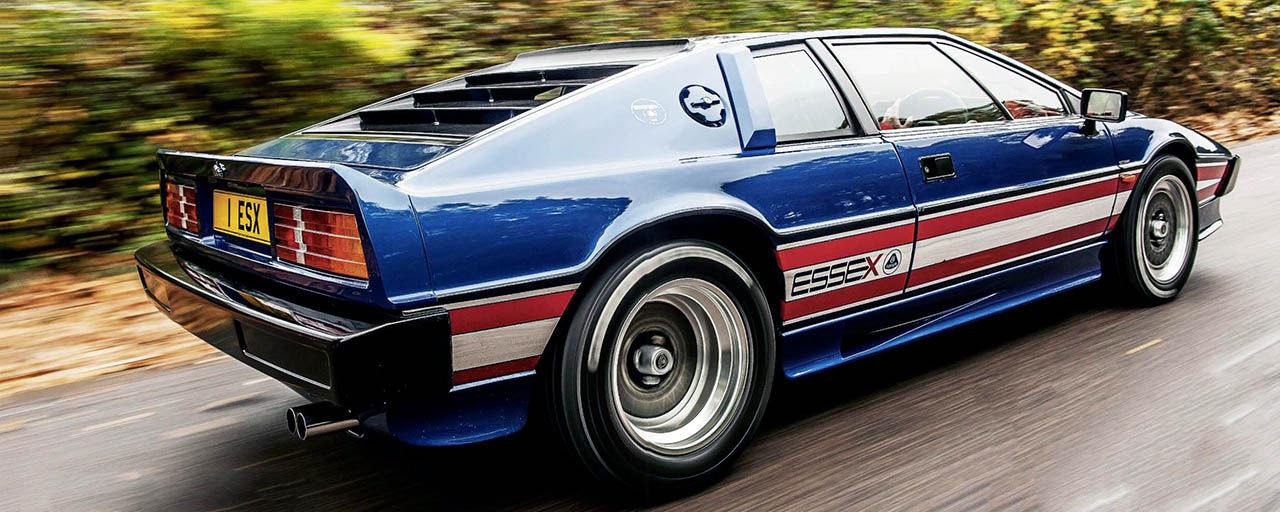
‘This has to be one of the smoothest fourcylinder engines ever created, revving easily to 7000rpm with a crisp, racy edge’
But, goodness me, it’s a treat to drive. Quick, sharp steering points the nose eagerly into a bend and the Lotus just streaks on round the curve, nailed to the road even when the power might be expected to push the nose wide or send the tail all a-slither. The more you drive it, the more you learn the steering’s dynamically varying weight and the springy gearchange’s momentum and your confidence builds until you feel an integral part of the machine in that typically Lotus way.
An original comes no more iconic – if you’ll excuse the over-used word – than our test car. It shines through the dull dampness of our test day with its three-tone colour scheme and near-luminous red interior, those red, metallic blue and silver exterior hues representing the logo of the most extravagantly-publicised oil company that you’ve never heard of.
Essex Petroleum – a mysterious operation whose precise function was unclear and whose equally mysterious boss, David Thieme, was curiously tight-lipped – was announced as the Team Lotus Formula One team’s lead sponsor at a lavish launch party at London’s Royal Albert Hall in February 1980. One of the three Lotus Turbo Esprits then in existence was revealed to the world for the first time during the event, sharing the stage with Shirley Bassey.
The buying public had to wait a while longer before they could actually buy a Turbo Esprit; the car featured here – which is number 11 of the 35 Essex editions that comprised the first batch of Turbos – wasn’t registered until New Year’s Day 1981. Lotus and Essex – the latter destined to disappear as rapidly and mysteriously as it arrived – wanted the world to think the partnership and the new car were more successful than they really were, so car 24 was rebadged as car 100.
Is the Lotus Turbo Esprit a supercar? If it’s as good as this one – and plenty aren’t, so tread carefully around obstreperous shifts from the Citroën-sourced gearbox, tired turbos, tatty bodywork and disintegrating cabins – then we say yes.
OWNING ONE
Barrie Cornes is a huge fan of these mid-engined Lotuses; as well as this Turbo, he has two other Esprits including the S3 featured in Classic Cars back in 2011.
‘There were two Essex Esprits for sale when I was looking for one, but the other one had been repainted and retrimmed whereas this one is all original, including the interior. It wasn’t restored, just recommissioned.
‘I’ve had it for eight years, and usually drive it around 2000 miles a year. It has the dry-sump engine used only in the first 150 cars, and the overhead stereo that later became an option.’
TECHNICAL DATA LOTUS TURBO ESPRIT
Engine 2174cc, four-cylinder, dohc, 16 valves, two Dell’Orto 40DHLA carburettors, Garrett T3 turbocharger
Power and torque 210bhp @ 6000rpm; 200lb ft @ 4000rpm
Transmission Five-speed manual, rear-wheel drive
Steering Rack and pinion
Suspension Front: upper wishbones, lower transverse links triangulated by anti-roll bar, coil springs. Rear: double transverse links, radius rods, coil springs
Brakes Servo-assisted ventilated discs all round
Weight 1148kg
Performance Top speed: 141mph; 0-60mph: 5.6sec
Fuel consumption 21mpg
Cost new £20,900
Values now £8500-£16,500

David Thieme insisted that the Turbo be fitted with a £1000 roof-mounted Panasonic IC stereo System. Early Turbo Esprits used dry-sump lubrication, but switched to a wet-sump system in June 1981.
{module Lotus Esprit Club}
ALPINE-RENAULT GTA TURBO
We weren’t supposed to call them Alpines in Britain because Peugeot-Talbot owned the name. But everyone does because that’s what they are. However, whether it wears an A-with-an-arrow or a Renault diamond badge on the nose it’s a fascinating take on the idea of a rear-engined sports car.
This particular GTA is a Le Mans Edition, which came with split-rim BBS alloy wheels rather than the standard GTA’s original turbine-spoke fitments. John Sweet’s car has slightly bigger and wider replacement BBS wheels with broader tyres to suit – and it takes just a couple of passes through the Snake and a few highspeed bends on the test track’s main circuit to reach the welcome conclusion that it’s much more stable and rather better balanced than I had feared it would be.
The steering weights up considerably as cornering forces rise – a characteristic designed to keep the Alpine stable at speed – and there’s mighty traction from that heavy, wide-tyred tail. Tentative efforts to break the grip have little effect – you need to keep the power on, wait for the turbocharger to deliver its torrent of boost then turn into a bend and back off for that to happen. In other words, the Alpine shows no sign of biting unless you really provoke it – it just hunkers down and flies, eventually past 150mph.
The gearchange is sweet if rather narrow in the gate and the brakes are firm and confident. But the engine is a total delight – strong, smooth and six-cylinder sonorous – but sits upright so its centre of gravity is higher than the 911’s. The threat of response lag from the near-ubiquitous Garrett T3 turbocharger promises precarious dynamics but at least the GTA doesn’t have the rear swing axles that were used by some earlier Alpines, so is that prejudice-fuelled promise kept?
I hope not, because this is a stunning-looking car and I’d really like it to drive as it looks. As it happens, it does. Contemporary road tests criticised the Alpine’s turbo lag but its boost is never so late in coming that it catches you out and would leave the 911 Turbo – a car of yawning low-revs lag – far behind on a twisty, unfamiliar road. You probably weren’t expecting that. Nor was I. At the heart of all of this talent is the Peugeot/Renault/Volvo all-aluminium 90-degree V6 engine also found in the DeLorean, but with the turbocharger and even firing intervals that John Z’s car lacked. These improvements came to the engine (which was originally meant to be a V8, hence the unusual vee-angle) quite late in life and resulted in 200bhp and 210lb ft of torque.
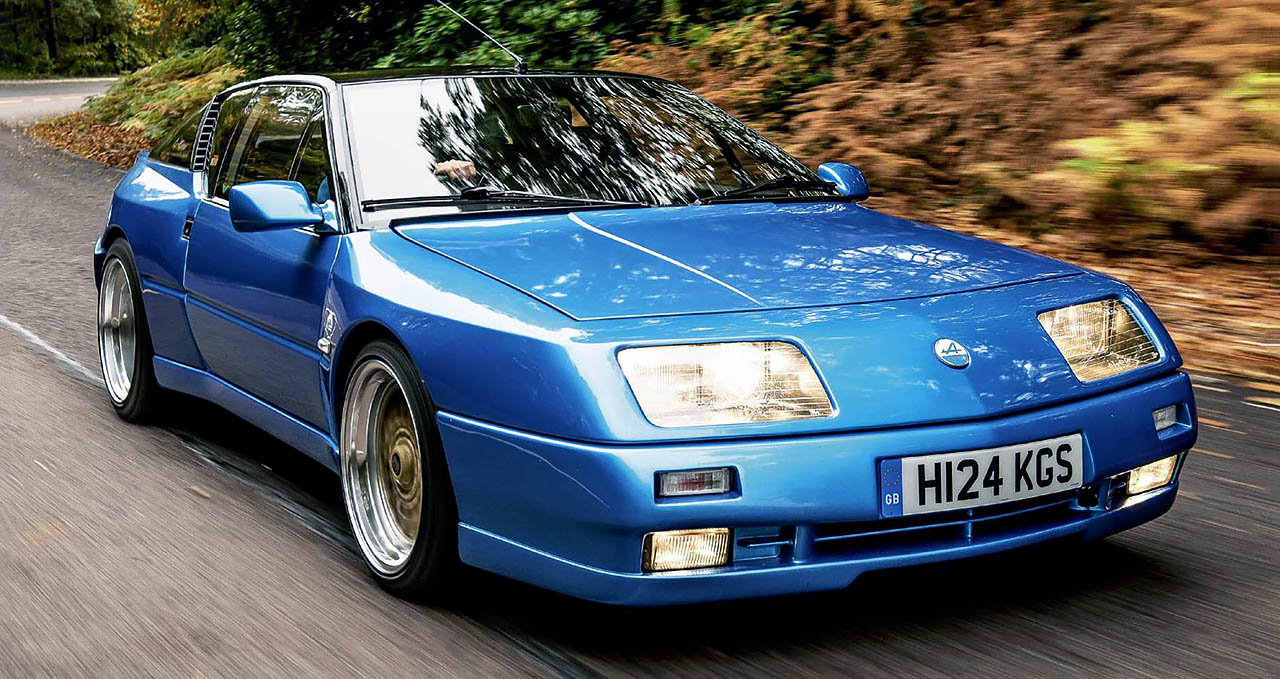
‘The Alpine shows no sign of biting unless you really provoke it – it just hunkers down and flies, eventually past 150mph’

Le Mans cost nearly £7000 more than a standard GTA despite unassisted steering and optional dealer-fit air-conditioning. Engine is mechanically identical to Renault 25 Turbo unit, but Alpine’s three-way catalyst saps power by 15bhp.
The composite-plastic body and the slim-pillared glasshouse have a crisp-edged angularity and the minimum of clutter with headlights nestling behind flush-fitting covers, while the interior is all straight lines and definite angles. You sink into a low seat next to a high centre tunnel bedecked with switches, mostly for the stereo system.
The scuttle is similarly low, giving a great view forward. More Porsche-shared snippets include floor-hinged pedals, a pair of tiny rear seats and a small boot under the bonnet lid. There’s no luggage space behind the engine, though, unlike the Lotus whose engine is ahead of the transaxle – which makes space for a boot behind it but no rear passengers.
The mystery is that the Alpine GTA and the A610 that it later became aren’t held in higher esteem – they are much better than some gave them credit for when they were new. Rust in the steel chassis is a problem, likewise a tendency for the hot engine bay to degrade rubber hoses (silicone replacements are sensible) and electrics, but as a dramatic and surprisingly practical driving machine there’s nothing to be afraid of. And everything to enjoy.
OWNING ONE
John Sweet manages Club Alpine Renault’s website and has owned this Le Mans Edition for six years.
‘It was originally a demonstrator at Old Oak garage in Enfield,’ he says. ‘All 26 right-hand-drive Le Mans cars were burgundy but a customer wanted one in blue so he bought the demonstrator – number 19 – and had it repainted. ‘Mechanically it was very good when I bought it, but the detailing was not. Renault built these cars with the cheapest parts possible, but charged Porsche prices!’
TECHNICAL DATA ALPINE-RENAULT GTA TURBO
Engine 2458cc, V6, sohc per bank, 12 valves, Renix electronic fuel injection, Garrett T3 turbocharger, Intercooler
Power and torque 200bhp @ 5700rpm; 210lb ft @ 2500rpm
Transmission Five-speed manual, rear-wheel drive
Steering Rack and pinion
Suspension Double wisbones, coil springs, anti-roll bar front and rear.
Brakes Servo-assisted ventilated discs all round
Weight 1180kg
Performance Top speed: 151mph; 0-60mph: 6sec
Fuel consumption 22mpg
Cost new £23,635
Values now £4650-£9900
Turbocharging’s turbulent times
Porsche went down the turbocharged route in 1973 with a prototype 911 Turbo that went into production two years later. Turbocharging is simply a way of increasing an engine’s efficiency. It can be used to get more power and torque out of an existing engine or it can do the same for a smaller engine to give it the outputs of a bigger (but normally aspirated) one. There are tripwires on the route to efficiency nirvana, though, and back in the Eighties they caused a few stumbles.
The emphasis then was on turbocharging as a route to hefty power increases without the weight and complexity of a bigger engine and more cylinders. But with turbo boost came high combustion pressures, sometimes suddenly, and engine-wrecking detonation was always a danger before the wastegate opened to release the excess boost. So compression ratios were low, which made for feeble performance until the turbocharger spun up to speed.
This made engines inefficient and thirsty off-boost, and still quite thirsty on boost especially if the fuelling was enriched at full throttle to help cool the intake charge.
As emissions rules tightened, turbocharging fell out of favour for petrol engines although it was always vital for coolerburning diesels. Today, though, turbocharging is right back in fashion, not just for performance cars but also for the new generation of downsized engines that power-match and out-torque the larger, naturally aspirated units they are rapidly supplanting while posting dramatically lower CO2 figures. How so?
Direct fuel injection is one reason. Here, fuel is injected into the combustion chamber on the compression stroke instead of into the inlet port, and the spray has a cooling effect that means the compression ratio can be higher.

The rest is down to electronic controls, metering the fuelling, the ignition and the wastegate more accurately so the engine can run nearer to detonation without reaching it, varying the valve timing, and – with a drive-by-wire throttle – opening the throttle further when off boost and keeping it partly open during gearshifts to keep air flowing through the engine, therefore keeping the turbocharger spinning.
Today’s economy-car petrol engines routinely give around 120bhp and emit less than 100g/ km CO2 per litre. It seems the turbocharger is here to stay.

Plumbing in a turbo sent the normally aspirated Esprit’s 160bhp output soaring to 210bhp Marrying turbo power with permanent four-wheel drive was the key to the Quattro’s success Rallye Sport-badged fast Fords exploited the advantages of turbocharged power to the full Bentley’s long association with turbocharging goes back to 1929 – though Walter Bentley wasn’t keen Renault applied lessons learnt from its Seventies turbocharged sports cars to hot road cars.
Like more than half the cars here, the Alpine relies on turbocharger maker Garrett for its added zing.
FORD ESCORT RS TURBO
Ford fans will doubtless howl with horror, but the Escort XR3i was never a great car. So why should the car you see here be any different? Surely it’s just a turbocharged XR3i with a bodykit? Not exactly. In Fordspeak, RS means ‘intended for motor sport’, and road RS cars are essentially homologation specials. So the rally derivative of the XR3 – itself a crisply designed machine tilting at the VW Golf GTI but falling short in driving dynamics – was first revealed as the Escort RS1600i. It had bold graphics, tweaked suspension, RS-pattern wheels and solid tappets to make the CVH (Compound Valve-angle Hemi) engine – already uncouth at high revs even with hydraulic tappets – rougher still.
The RS Turbo was Ford’s second attempt at powering the Escort further up the rankings. It was a more interesting road car than the RS1600i and better than the XR3i instead of being just different. I well remember our attempts during a Motor road test to record a maximum speed on Millbrook Proving Ground’s banked bowl. It rocketed up to speed with alarming vigour but then hesitated, making it impossible to record a flying lap. It turned out that Ford’s press garage had been playing about with the boost settings in the hope of bagging some startling performance figures. It was still quick though – it was rare for any hot hatch to get from 0-60mph in under eight seconds back then.
Today it seems keenly brisk rather than searingly speedy but our test car’s engine spins more sweetly than any CVH I’ve experienced before and there’s little turbo lag. Best of all, the Ferguson-designed (but GKN/ZF-made) viscous-coupled limited-slip differential turns normal front-wheel-drive handling on its head. I expected it to run wide under power and tuck its nose in – with varying degrees of upset to the tail – when I lifted off but in fact the Escort does the opposite. It pulls ever more keenly into the curve as I pile on the power, washing out again when I ease off as befits softer rear suspension than the XR3i’s.
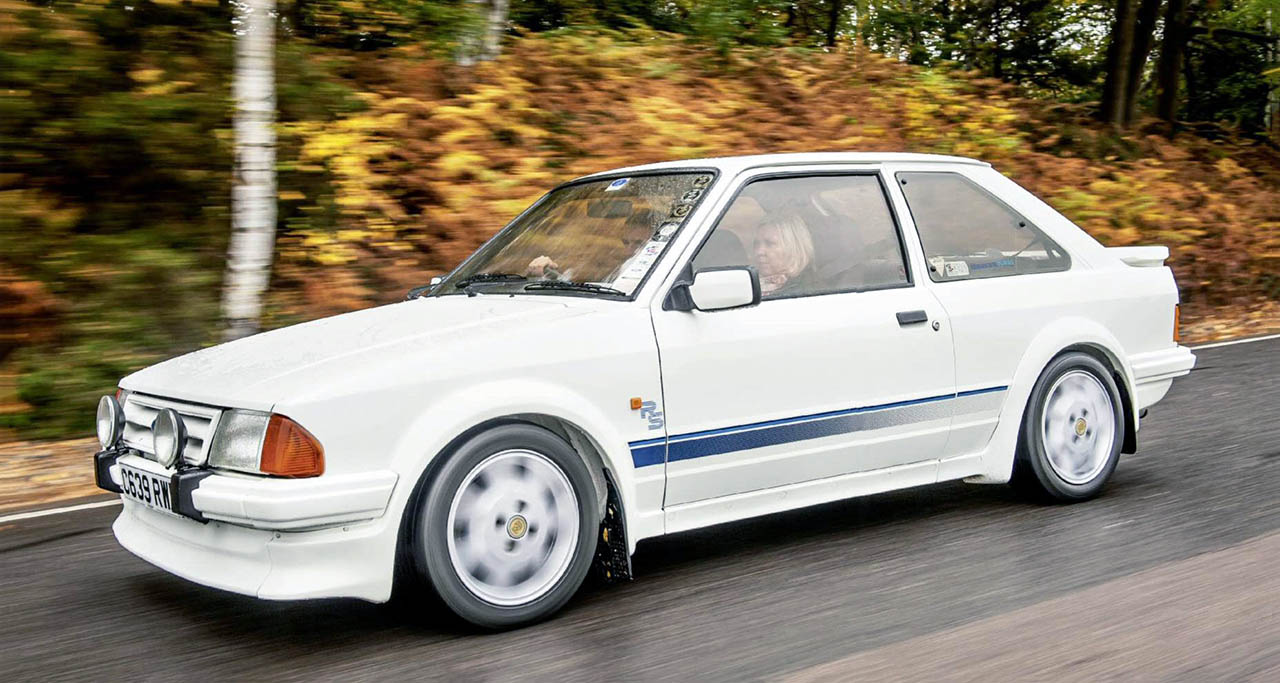
As a result, it doesn’t just feel near-immune to lift-off oversteer – it almost feels capable of power-oversteer. But once I’ve got the hang of these curious characteristics and the gentle tugging and locking of torque steer on gentle bends and unevenly slippery surfaces, I discover that I can use the RS’s huge grip to corner very quickly. The 1986-on facelifted RS Turbo by comparison wasn’t as edgy, but spoilt by a harder ride and therefore ultimately less fun.
Launched in 1985, the original RS Turbo’s strengthened engine reverted to hydraulic tappets, gained fully mapped ignition – which also controlled the Garrett T3 turbocharger’s wastegate – and power rose from the XR3i’s 105bhp to 130bhp.
Transferring this to the road with a degree of decorum called for better location of the front MacPherson struts, which gained forward-facing tie bars to create lower wishbones instead of relying on the anti-roll bar to triangulate the track control arms. And most exotically of all, of course, that limited-slip differential.
Ford made all 5000 RS Escorts at Saarlouis in Germany. It’s a great-looking car in white (the only colour offered), but more dated inside, with probably one of the last dashboards ever made to feature a central speaker grille. But what were seen as character flaws back then seem more like intriguing period foibles now, and as far as the classic car world is concerned original is certainly best. That the auction at November’s NEC Classic Car Show saw a perfect, 5568-mile example of a similar white RS sell for more than £60,000 makes the point well enough…
OWNING ONE
‘I grew up with the Escort MkI and MkII so I’ve always wanted one,’ says Steve Perkins. ‘Then 24 years ago I sold everything I had and bought this RS – only to discover that I couldn’t insure it.
‘It’s always been a second car and is standard except for the exhaust – which I might change – and has done just over 70,000 miles. The body has never been welded and has all its original panels – and lots of Waxoyl. I try to keep it original by using Ford parts. The only problem it’s had is a weeping master cylinder, which I’ve had sleeved because you can’t get new ones any more.’
TECHNICAL DATA FORD ESCORTRS TURBO
Engine 1597cc, four-cylinder, sohc, eight valves, Bosch KE-Jetronic fuel injection, Garrett T3 turbocharger, intercooler
Power and torque 130bhp @ 6000rpm; 133lb ft @3000rpm
Transmission Five speed manual, front-wheel drive,LSD
Steering Rack and pinion
Suspension Front: MacPherson struts, coil springs, transverse links triangulated with tie bars, anti-roll bar. Rear: MacPherson struts, coil springs, transverse and trailing links, anti-roll bar
Brakes Front: ventilated discs. Rear: drums
Weight 971kg
Performance Top speed: 126mph; 0-60mph: 7.8sec
Fuel consumption 28mpg
Cost new £9250
Values now £3000-£8000

RS Turbo’s interior is identical to the XR3i’s, bar new Recaro seats. RS Turbo needed bigger, stronger transaxle teeth and a braced gearbox casing to cope with 130bhp.
‘The Escort pulls ever more keenly into the curve as I pile on the power – it almost feels capable of power-oversteer’
RENAULT 5 GT TURBO
Renault may have made the first turbocharged hot hatchback but there were two others before this one, both based on the original Renault 5 – the Gordini Turbo and the mad, mid-engined roadgoing rally car that followed.
Renault turbocharged the second-generation – and now transverse-engined – R5 for the 1986 model year and called it the GT Turbo. Suddenly the genre-redefining Peugeot 205 GTI 1.9 had its first serious, fully formed rival.
It was always a riot to drive and age certainly hasn’t lessened its exuberance. It snicks well under eight seconds to 60mph and pulls in the higher gears with mass-defying vigour. It uses the smaller Garrett T2 turbocharger to reduce mass and lag and as with the Lotus Esprit, it blows through a carburettor – in this case a singleventuri Solex sitting in an airtight box. It blows quite hard too – up to 0.7bar – resulting in 115bhp.
The later Phase Two example we have here has 120bhp and its throttle response is akin to having an elastic band attached to the accelerator cable rather than just waiting for boost to arrive in a rush. The 1397cc engine may have old-tech pushrod valvegear, but who cares when it’s happy to rev sweetly all the way to 6700rpm?
It’s frisky and demands to be thrown about, simultaneously grippy on its little 13-inch wheels and elastic in the way that every movement of the steering seems to load up springy tension in the suspension as the nose dives in. It never settles, constantly telling you something, like a puppy wanting to play. For example, you know how the front wheels are coping with the demands of torque and grip, but the tugs are never unruly – they’re just part of the endless conversation.

The rear suspension is soft enough to keep its wheels stuck firmly to the road and uses a novel variation of the trailing arm and transverse torsion bars design. Each wheel is sprung, not by one long bar, but two short bars that double back on themselves and are joined together at the Renault’s centre line. The idea is to use the ensemble as an anti-roll bar without raising each wheel’s spring rate. It’s ingenious and works very well – which is true of the whole car, actually – including its slippery but positive gearchange and firm, short-travel brakes.
And it has the show to match the go. Phase One cars featured a latticework front grille, angular wheelarch and sill extensions and handsome alloy wheels with an internally toothed central recess. The Phase Two lost the earlier car’s unique face in favour of a generic R5 frontage but gained a body-coloured bodykit and rather unimaginative-looking five-spoke alloy wheels. In this guise the boxy GT Turbo looks almost discreet.
Thankfully the cabin revives the revs with what looks like a repeated rising bar-graph motif on the seats – in red, of course – chamfered gearknob and a leather-rimmed steering wheel with three cranked spokes. These unusual go-faster motifs are overlaid on a dashboard rooted in an Eighties notion of futurism – all hooded dials and piano-key switches – with a wiper stalk emerging not from the steering column but at an angle from the dashboard. Hard plastic abounds and there’s a manual choke. How quaint.
It’s hard to fathom why standard GT Turbos are so rare now. Perhaps it’s because they can be modified very easily to go even faster – but bulldozing them into being rock hard, rabid racers ruins their road-friendliness.
Far better to find a solid, standard and unabused one if you can. Treasure it. And then watch its value rocket.
OWNING ONE
Jeremy Townsend is Renault UK’s PR director and has spent years amassing some intriguing machinery like this GT Turbo to promote Renault’s history.
‘Finding an original 5 GT Turbo was difficult because owners frequently modify them,’ he says. ‘This car’s previous owner had had it for years and it was in nearperfect condition when we bought it in 2014. It even has the original exhaust and interior.
‘GT Turbo Spares fitted a new clutch and addressed some minor body corrosion and now it’s used for dealer and press events.’
TECHNICAL DATA RENAULT 5 GT TURBO
Engine 1397cc, four-cylinder, pushrod ohv, eight valves, Solex 32 DIS carburettor, Garrett T2 turbocharger, intercooler
Power and torque 120bhp @ 5750rpm; 122lb ft @ 3750rpm
Transmission Five-speed manual, front-wheel drive
Steering Rack and pinion
Suspension Front: MacPherson struts, lower wishbones, coil springs, anti-roll bar. Rear: trailing arms, four transverse torsion bars
Brakes Discs all round, ventilated at front
Weight 831kg
Performance Top speed: 120mph; 0-60mph: 7.8sec
Fuel consumption 30mpg
Cost new (Phase 2) £8405
Values now £2000-£6500
‘The Renault is frisky and demands to be thrown about. It never settles, constantly telling you something, like a puppy wanting to play’
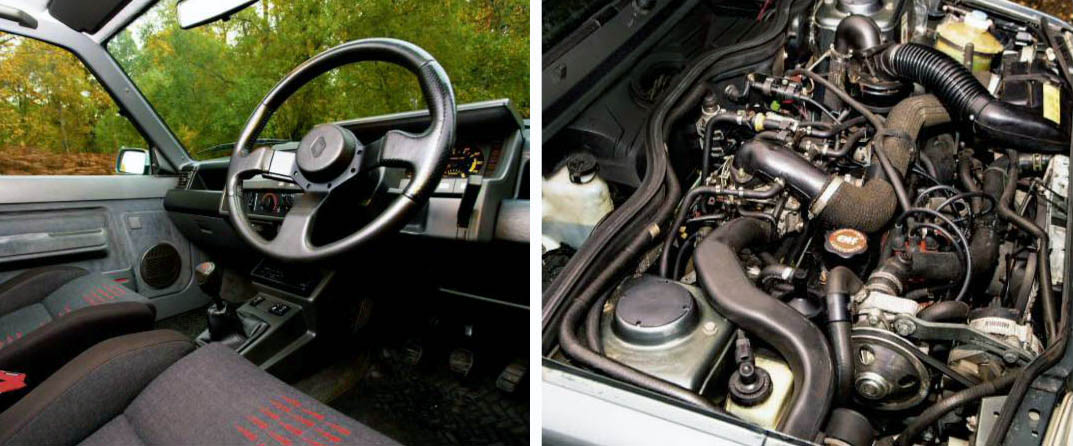
Angular dashboard and piano-key switches shout Eighties futurism. Phase 1 GT Turbo’s hot-starting issues were partly alleviated on later cars by a separate fan to cool the carburettor.
{module RENAULT 5 GT}
PORSCHE 911 TURBO 930
Insiders call it the Porsche 930, but adding the Turbo tag to the 911 name evokes more visceral responses among devotees. All that explosive energy is concentrated in a tail that’s even heavier than a regular 911’s – a result of moving the engine back 30mm to house a new clutch plate with a thick, rubber-damped hub in the later 3.3-litre version. Thus was the 930’s balance further compromised in a bid to banish gearbox chatter. No doubt that silent transmission will be a comforting thought if I spin tail-long into a hedge.
So, having been blown away by the fabulous Arrow Blue paintwork (Guards Red is so obvious) I feel a frisson of fear as I slot behind the wheel. Period car magazines played down all that turbo-rush- to-doom stuff – when confronted with lift-off oversteer on a greasy downhill bend Motor reckoned, ‘Provided that an accurate amount of opposite lock is quickly applied, this is no problem as the car will very rapidly sort itself out.’ The slide resulting from a surfeit of power was largely self-correcting too, apparently.
With that in mind I nevertheless find myself wondering where all that much-vaunted power is; there’s little more than a whiff of boost at town pootling or open cruising speeds. So I find a stretch of open road, steel myself into boost mode then press the accelerator hard down. And wait. And wait. And then I wait some more. And then – whoosh! – we’re hurtling off towards the horizon.
Keeping the revs up keeps the boost on song and makes progress very rapid indeed. Motor fired its example to 60mph in just 5.3 seconds, inflicting who knows what torture on the transmission given the 930’s reluctance to spin its rear wheels. No production car of the time (1979) accelerated more ferociously.
The problem is that its ultimate performance potential remains tantalisingly out of reach unless you’re really on it. Fuel is squirted by Bosch K-Jetronic mechanical injection into air compressed by a hefty KKK turbocharger at up to one bar of boost, but the fact that maximum torque doesn’t arrive until 4000rpm and only really starts to be affected by boost pressure above 2500rpm – according to the published torque curve – gives an idea of how this engine behaves. Disappointingly the turbo absorbs the usual metallic flat-six wail too.
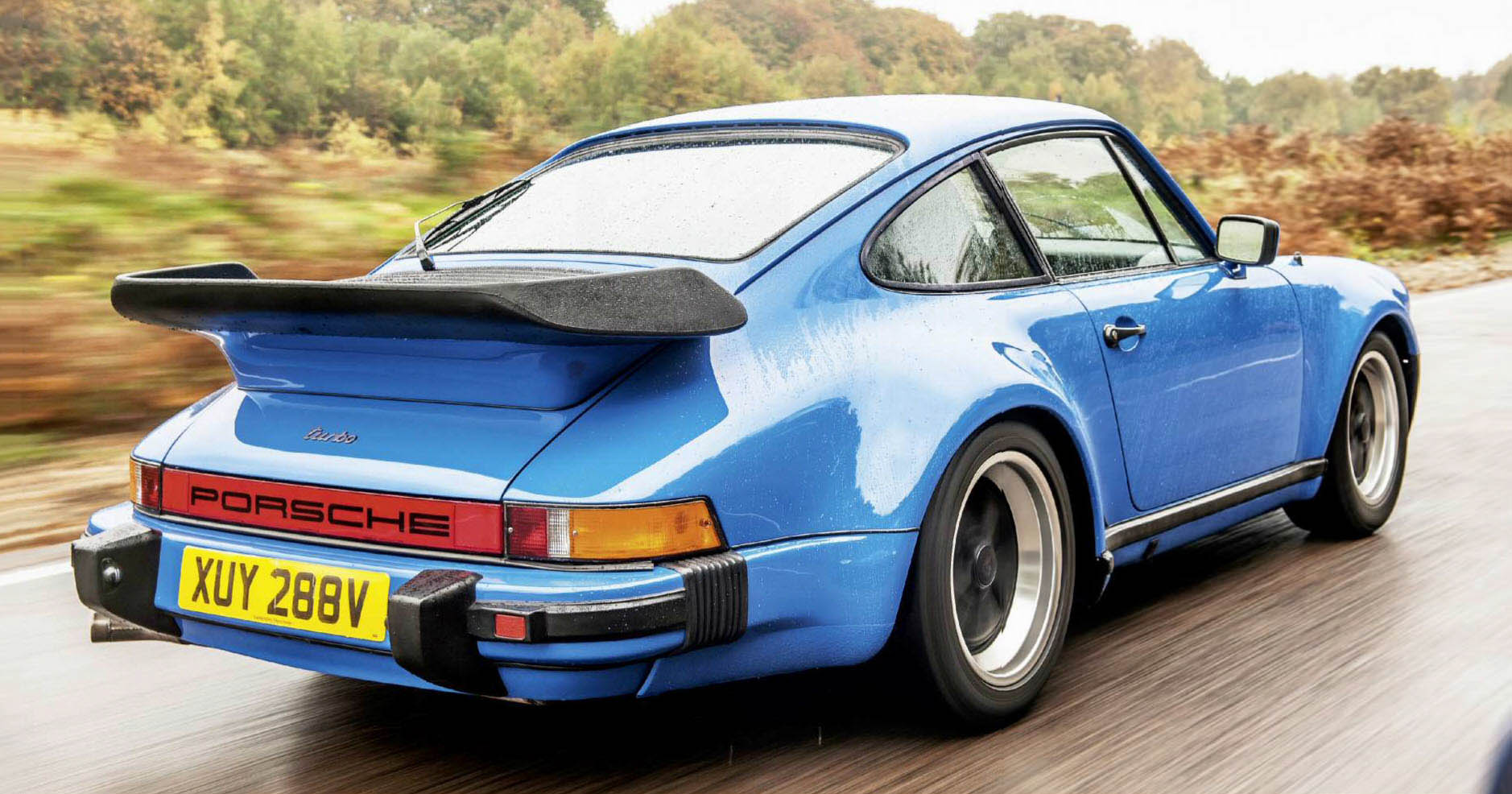
If there’s an upside it’s that the 930 grips impeccably and steers beautifully when you drive it off-boost. Only when you wind it up does the tail start to move around – at which point you’d better be ready with that opposite lock.
Another thing to strike me about our test car is that I have never experienced a pre-1988 911 gearbox as slick-shifting as this one – it’s not quite the same as the other so-called 915 gearboxes I’ve tested because its stronger casing contains beefier components and it has only four forward gears.
Then there’s the looks – they set the scene perfectly for the 930’s role as a scary monster, with arches stretched out over fat, deepdished wheels and the first incarnation of the 911 whale-tail spoiler. This was the mad mutant offspring of the demure, sensual 911 with 260bhp at launch with three litres in 1974 then 300bhp from 1977 thanks to increased engine capacity and the addition of an intercooler set horizontally above the engine.
Prices of 930s are rocketing ahead of those of other impactbumper cars and nudging pre-impact levels, so the fact that this car is currently on offer for £79,000 makes it a snip in today’s market. That said, I’d derive more pleasure more often from a good naturally aspirated 911. At least I’d know what it would do next.
OWNING ONE
‘Porsche dealer Piave Motori in Italy supplied it new in 1979 to a Signor Malvicini, whose name is on a plaque in the car,’ says JZM Porsche’s sales director Russ Rosenthal. ‘He kept it until 1993 and Piave Motori looked after it.
‘Unusually for an Italian car, the paper service history is complete with all the handbooks including the one for the original Blaupunkt radio. It came to the UK in 1999 and has had three UK owners since then.
‘We’re in no hurry to sell it – we’re happy just to keep it here and use it occasionally at weekends. Best of all, having lived so long in Italy, it has no rust at all!’
TECHNICAL DATA PORSCHE 911 TURBO
Engine 3299cc, flat-six, sohc per bank, 12 valves, Bosch K-Jetronic fuel injection, KKK turbocharger, intercooler
Power and torque 300bhp @ 5500rpm; 303lb ft @ 4000rpm
Transmission Four-speed manual, rear-wheel drive
Steering Rack and pinion
Suspension Front: MacPherson struts, lower wishbones, torsion bars, anti-roll bar. Rear: semitrailing arms, torsion bars, anti-roll bar
Brakes Servo-assisted ventilated discs all round
Weight 1308kg
Performance Top speed: 160mph; 0-60mph: 5.3sec
Fuel consumption 18mpg
Cost new £26,249
Values now £35,000-£75,000

Turbo has a smaller steering wheel than other 911s and a 7000rpm – not 8000rpm – rev-counter. Air-to-air intercooler dominates 1977-on Turbo’s packed engine bay and reduces charge air temperatures by up to 60 deg C.
‘Only when you wind it up does the tail start to move around – at which point you’d better be ready with opposite lock’
{module Porsche 930}
BENTLEY TURBO R
Bolting Garrett’s biggest automotive turbocharger – the T04B – to a mighty all-aluminium, 6750cc pushrod V8 is enough to rock the foundations of any gentleman’s-club-on-wheels. But that’s exactly what Rolls-Royce did to the Bentley Mulsanne in 1982, making it meaningfully different from its Rolls-Royce counterpart for the first time in decades. Suddenly Bentley – a marque of former sporting glories – had a point once again.
However, it took the 1985-on Turbo R (for Roadholding) to improve the handling with stiffer front and rear anti-roll bars, firmer dampers – though the springs were left alone – and a Panhard rod to prevent the softly mounted rear subframe from moving sideways. It was much easier for the Turbo R to maintain decorum when deploying all that torque and roasting the rear tyres on a slithering, smoking junction exit – something we Eighties roadtesters found endlessly entertaining – and yet there was remarkably little damage to the wafting ride comfort.
It’s tempting to smoke the tyres on Alan Hills’ car for old times’ sake, but instead I whoosh away with a sense more of rapidly and discreetly gathering momentum than immense acceleration. It’s not immediately obvious that the engine is turbocharged but the torqueconverter slip, turbo lag, torque and distant V8 woofle all merge into soft-edged but insistent thrust more or less whenever I want it.
Sitting high in this enclosed world, I sense not that I’m passing the scenery, rather that the scenery is passing me. And yet the Turbo R can change direction pretty smartly and seems to marshal all the considerable forces it generates into useful directions when I tackle The Snake. All I have to do is allow it enough room to do so.
A far cry from the earlier Mulsanne Turbo, then. In its original form – with the turbo blowing through a giant four-barrel Solex carburettor – it generated 328bhp and 450lb ft of torque, figures that were undisclosed at the time because Rolls-Royce considered comparisons unbecoming. This meant that whereas it took a Rolls- Royce Silver Spirit or a regular Mulsanne 10.3 seconds to swish to 60mph, the Mulsanne Turbo managed it in 6.7 seconds. Impressive for a car weighing comfortably more than two tons and whose engine never ventured beyond 4650rpm.

There was just one snag – new tyres aside, nothing at all had changed within the chassis so the Turbo’s dynamic abilities were overwhelmed by the new forces acting on them. There were improvements prior to the Turbo R of course – the arrival of fuel injection in 1987 improved economy, the fractional power drop amply compensated by increased torque, and an intercooler followed a year later. A new – but still GM – four-speed automatic gearbox replaced the old three-speeder a couple of years after that and Zytek fuel injection replaced the old Bosch system in 1995, at which point the long-wheelbase RL version became standard issue.
Except that Rolls-Royce and Bentley, still together back then, never adhered to arbitrary standards if the customer wished otherwise. Which is why our test Turbo R – a very late example from 1997 – has the original short wheelbase.
It seems out of place among all the sporting machinery here. It towers above them, displaying not a single piece of go-faster bodywork addendum, while inside it’s a cocoon of Champagne leather, deep rugs and mirror-smooth wood inlays.
Effortless? It defines the term and you can experience it for as little as £10,000. Sub-15mpg fuel consumption frightens many off, but typical asking prices still seem ludicrously cheap.
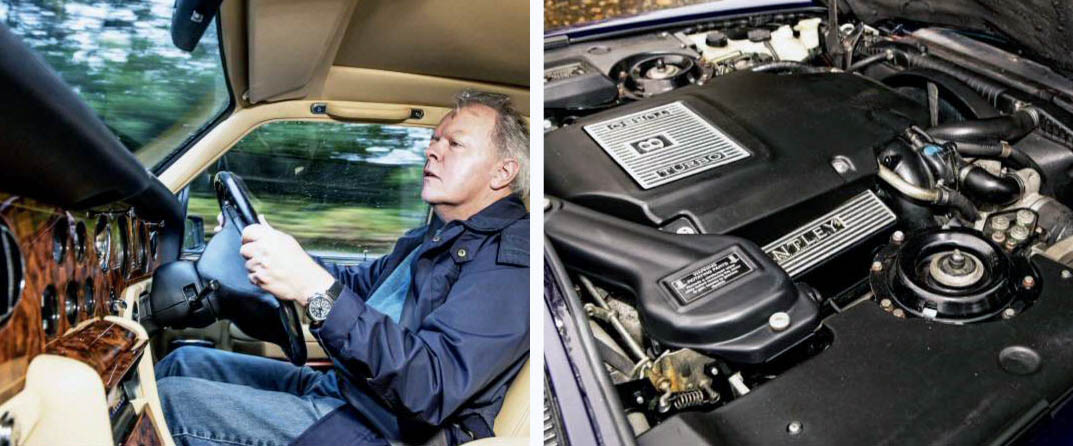
Simister resists the urge to burn rubber – ‘something we Eighties roadtesters found endlessly entertaining. Turbo R’s intercooler changed from air-to-air to water-to-air during the switch from Bosch to Zytek engine management in 1996.
‘The Turbo R maintains decorum when roasting the rear tyres on a slithering, smoking junction exit, with remarkably little damage to the ride comfort’
OWNING ONE
Alan Hills has owned older Bentleys for years. ‘But then everything went to pay for my grandson’s education,’ he says. ‘Now I’m back with this Turbo R, which I’ve had for about 19 months. It’s great fun and hasn’t let me down yet. I drive it all over the place – it recently won an award ribbon at the Bentley Drivers’ Club concours – and I don’t have to increase the radio volume or raise my voice, even at high speeds.
‘It was ordered new from HR Owen by a man called Haydon Baillie. He specified his own shade of blue and the special wood, picnic tables and rear quarter mirrors, all of which the ladies love.’
TECHNICAL DATA BENTLEY TURBO R
Engine 6750cc, V8, pushrod ohv, 16 valves, Zytek fuel injection, Garrett T04B turbocharger, intercooler
Power and torque 320bhp @ 4200rpm; 455lb ft @ 2400rpm
Transmission Four-speed automatic, rearwheel drive
Steering Power-assisted rack and pinion
Suspension Front: double wishbones, coil springs, anti-roll bar. Rear: semi-trailing arms, coil springs, auxiliary air springs, anti-roll bar
Brakes Discs all round, ventilated at front
Weight 2205kg
Performance Top speed: 143mph; 0-60mph: 6.5sec
Fuel consumption 15mpg
Cost new (four-headlamp version) £91,776
Values now £10,000-£22,000
‘Some of these cars are old-school but others manage to get the best from their turbos while minimising lag and sudden boost’
WHICH BLOWER’S BEST?
Some of these cars – but the Porsche in particular – are as old-school as a turbo installation can be. Others with smaller engines (Bentley excepted) are better at getting the best from a turbo while still minimising lag and sudden boost.
Top billing should go to the Porsche for its ultimate pace and its near-legendary status but that old adage of not meeting your heroes holds true here – likewise the Quattro. The Escort RS is better-mannered than I remembered and a lot of fun while the Renault 5 is quite simply hilarious. Choosing between the Esprit and the Alpine is as tough a call now as it was back in 1986; both are terrific so let’s call it a draw, with the GTA remaining a well-kept secret. The Bentley is in a class of its own – an aristocrat with a racy secret life.
You know where this is going. The Lancia Delta HF Integrale has the best turbo installation here, the best roadholding, the best handling and the most spirited personality. Eight-valve Integrales haven’t been sucked into the value hype, but it can’t last long so buy one now. I know I would.
The eight-valve may be the cheapest of the Delta Integrale breed, but it’s also one of the best.
Thanks to: JZM Porsche at Kings Langley, Herts (jzmporsche.com); the Audi and Renault heritage fleets; the Lancia Motor Club; Andy Betts at thelotusforums.com; Club Alpine Renault; the RS Owners’ Club; the Bentley Drivers’ Club; and of course all the owners.
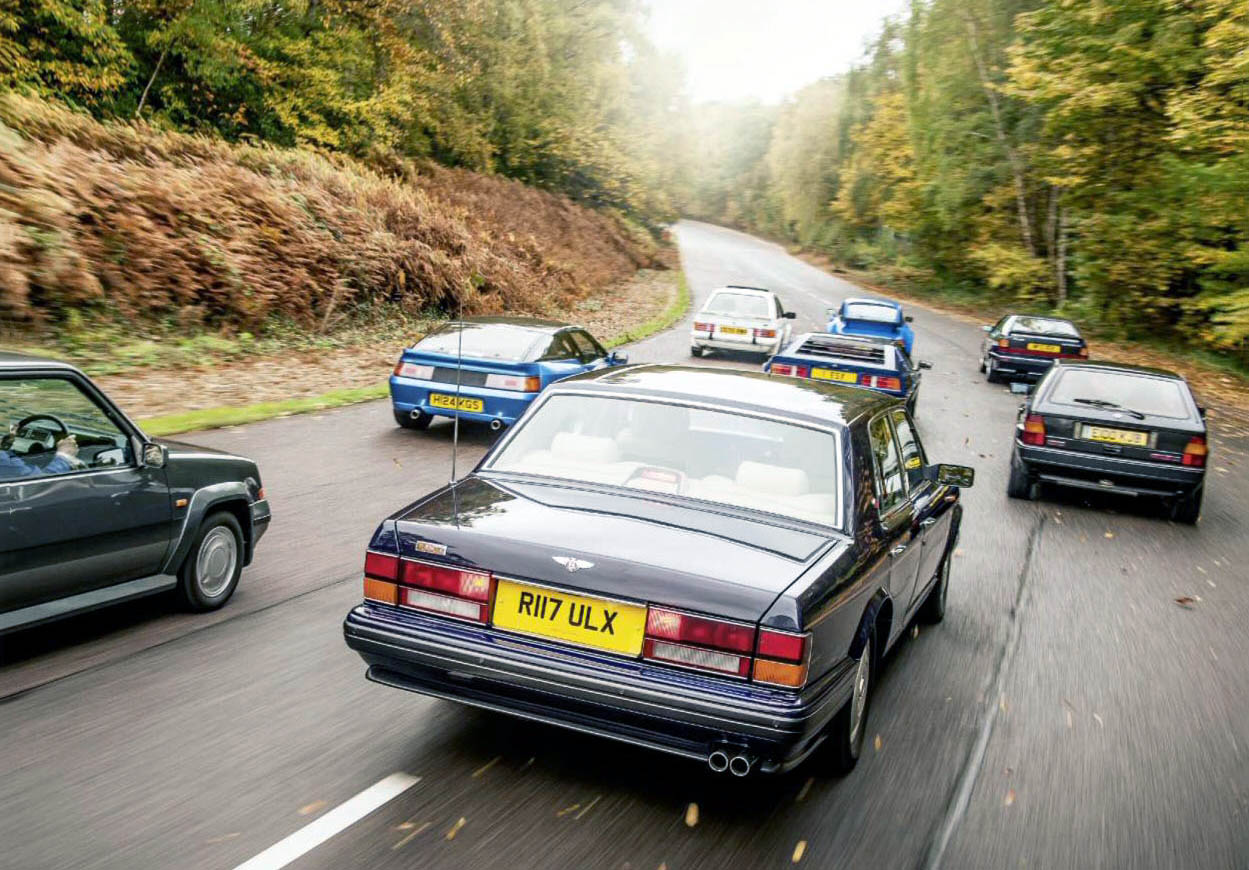
{CONTENTPOLL [“id”: 62]}





